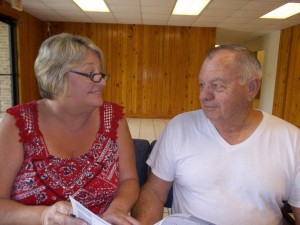by Monica Brinkley | Apr 26, 2012
 As I begin to age, I am finding that many of my co-workers, friends and I are dealing with aging parents. Often times, it is trying and difficult to communicate with aging family and friends. Hopefully, this article with give you some tips that will make talking with older adults just a little easier.
As I begin to age, I am finding that many of my co-workers, friends and I are dealing with aging parents. Often times, it is trying and difficult to communicate with aging family and friends. Hopefully, this article with give you some tips that will make talking with older adults just a little easier.
Three simple words can help you talk to the older adults in your life: stop, look, and listen. These words are important when you are in everyday conversation. But they are even more important when you are trying to solve a problem or get essential information. It only takes a little time to stop, look, and listen. When you do, you will quickly find that you will feel less stressed. Also, your older friend or family member will feel less frustrated and more understood.
Stop what you are doing and focus on your conversation. Of course, we talk to each other while we are doing other things. Talking while we do the dishes or drive the car is normal. Those are good times to talk about the weather, folks we visited with last weekend, or how cute our grandchildren are. But it’s different when we want to talk about something important. When we want to ask about a problem or be sure someone understands, we must stop, look, and listen. When we don’t stop what we are doing, our older friend or family member may not hear or understand us. We also may miss important nonverbal messages they are sending. For example, while coming out of the doctor’s office, you may quickly ask what the doctor said, but you also may be thinking about what you need at the grocery store. Take the time to stop and ask about the doctor’s comments before moving on. Focus on the appointment and ask for details while the information is fresh on your older family member’s mind.
Look at the older person when you are talking to them. Looking directly at a person lets them know we are paying attention and that we care about what they have to say. Because many older adults have some hearing loss, they hear better when they can look at the person who is talking. Without realizing it, most of us increase our hearing by reading lips. It is easier to read lips when the listener can clearly see the speaker’s face. So face the person you are talking to, avoid eating or drinking while you are talking, and be sure to speak in a strong, clear voice.
Listen with more than your ears. Listen for more than the words. Listen for unspoken messages. What is your older relative or friend telling you with his or her body language? Listen for the person’s tone of voice—is he or she angry, sad, scared, or excited? Listen for the message you see in the older adult’s face or posture. Listen with your ears, your eyes, your mind, and your heart.
Three simple words can prevent many misunderstandings. When we stop, look, and listen, we are showing our older relative or friend that we not only care, but also want to understand and to help. These three simple words are just the start of better communication.
Source: Stop, Look, and Listen: Tips for Talking to Older Adults, Carolyn S. Wilken, associate professor, Department of Family, Youth and Community Sciences, Florida Cooperative Extension Service, Institute of Food and Agricultural Sciences, University of Florida. Please visit the EDIS Web site at http://edis.ifas.ufl.edu.
by Elaine Courtney | Apr 25, 2012
 Are you feeling the stress of rapidly increasing gas and food prices? Today is a good day to begin changing your financial situation! Start by learning about important money matters and taking steps to improve your money skills.
Are you feeling the stress of rapidly increasing gas and food prices? Today is a good day to begin changing your financial situation! Start by learning about important money matters and taking steps to improve your money skills.
These five steps will help you on your path to “financial wellness.”
- Make a commitment. Changing your relationship with money is not easy—it takes hard work and commitment. Set a financial goal, commit to it, and become an American Saver at http://americasaves.org . Also, visit http://financialliteracymonth.com for more resources.
- Assess your financial situation. Don’t hide your head in the sand. Truly look at your financial situation by completing a net worth statement. Your net worth is the value of all of your assets minus the total of all of your liabilities. Put another way, it is what you own minus what you owe. Knowing where you are today will help you determine the best path toward meeting your financial goals. For a net worth worksheet: http://bit.ly/hjfnQP
- Get Organized. Getting your financial house organized is a great way to begin on a clear path toward financial wellness. Visit Organize Your Financial Life or your local Extension office to receive a free copy of the “Money Management Calendar.”
- Set priorities. Understanding the difference between needs and wants will help you establish financial priorities and set realistic goals.
- Live on a Spending/Savings Plan (a.k.a.—“budget”). Spending less than you earn is easier said than done! A solid plan is the most important element for financial success.
Changing money management habits and your relationship with money can be hard work, but the payoff is priceless. Remember: stay flexible on your financial journey, revisit your plan, and make needed changes. Additional resources
Author: Elaine A. Courtney
by Kendra Hughson | Apr 23, 2012
In the summer of 1997, Charles Moore of Long Beach, California, a furniture refinisher and seafarer was returning from a sailing trip through the seldom traveled Subtropical North Pacific only to realize his sailboat was encircled by a “plastic soup” for as far as he could see. In fact, Charles Moore had stumbled upon what is the largest garbage dump on the planet.
It is estimated that this discovery, now dubbed the Great Pacific Garbage Patch, a huge stretch of floating waste is actually more like a soup of confetti-sized plastic bits, produced by our lifestyle of throw away consumerism. This discarded ‘stuff’ has made its way into every ocean.
This garbage patch is literally trash that gets stuck in storm drains and is washed into rivers and out to sea, the legal and illegal dumping of garbage and appliances, and plastic resin pellets inadvertently spilled and unloaded by plastic manufacturers. In fact, plastic marine debris is now found on the surface of every ocean on earth.
And, no matter where the plastic litter originates, once it reaches the ocean, it becomes a global problem. Garbage travels thousands of miles as it is carried by many large system of rotating ocean currents.
Moore’s discovery prompted him to take on a cause. Charles Moore founded Algalita Marine Research Foundation (AMRF) in hopes of raising awareness about the oceans – plastic litter in particular.
Moore’s action falls right into the ecological discussions concerning Handprints…you know those positive ecological aspects of action towards sustainability and the environment that can occur on any scale without compromise.
There is a great deal of information concerning carbon footprints circulating. … the frightening things each and everyone of us is doing to the earth each and every day. Perhaps, if each of us took time to emulate ‘a guy who cared’ and improve upon our own, individual handprint we could make this world a more sustainable place for everyone and everything.
This Earth Day, think about your handprint and the capacity you have to influence others.
See You Tube video: NOAA Marine Debris
Author: Heidi Copeland
by Judy Corbus | Apr 6, 2012

Dye one set of eggs for hiding and another set for eating to reduce foodborne illness risk
Easter Egg coloring can be a lot of fun for the whole family, but it is important to remember to practice food safety. “Based on USDA’s statistics, the average consumer would encounter a contaminated egg only once in 42 years. And then, that egg would have to be time- and temperature-abused to contribute to a health problem,” (Egg Nutrition Center,1999). Time and temperature abuse is caused when food is not held or stored at the right temperature to kill viruses or bacteria. As consumers, we may purchase food that is safe, but it can become unsafe based on what we do with it after we buy it. From the moment our eggs leave the store’s refrigerated case, the timer is on. Some tips for keeping your eggs safe and avoiding foodborne illness on the way home include picking up refrigerated items last, bringing a cooler if you have to travel a while before you will return home, and immediately refrigerating items once you arrive home.
The USDA also recommends the following tips to help keep our eggs safe and avoid foodborne illness:
• Don’t take eggs out of the carton to put them in the refrigerator — the carton protects them. Keep the eggs in the coldest part of the refrigerator — not on the door.
• Raw shell eggs in the carton can stay in your refrigerator for three to five weeks from the purchase date. Although the “Sell-By” date might pass during that time, the eggs are still safe to use. (The date is not required by federal law, but some states may require it.)
• Always wash your hands with warm water and soap before and after handling raw eggs. To avoid cross-contamination, you should also wash forks, knives, spoons, and all counters and other surfaces that touch the eggs with hot water and soap.
• Don’t keep raw or cooked eggs out of the refrigerator for more than two hours.
• Egg dishes such as deviled eggs or egg salad should be used within 3 to 4 days.
In addition to carefully handling Easter Eggs, consider using two sets of eggs – one set for hiding and one for eating. Color extra eggs for the Easter Egg hunt or for decoration but set aside eggs in the refrigerator just for eating. Another option is to reserve the dyed Easter Eggs for eating and use plastic eggs for hiding. These can be filled with wrapped candy or other treats so they still make awesome finds!
 As I begin to age, I am finding that many of my co-workers, friends and I are dealing with aging parents. Often times, it is trying and difficult to communicate with aging family and friends. Hopefully, this article with give you some tips that will make talking with older adults just a little easier.
As I begin to age, I am finding that many of my co-workers, friends and I are dealing with aging parents. Often times, it is trying and difficult to communicate with aging family and friends. Hopefully, this article with give you some tips that will make talking with older adults just a little easier.

